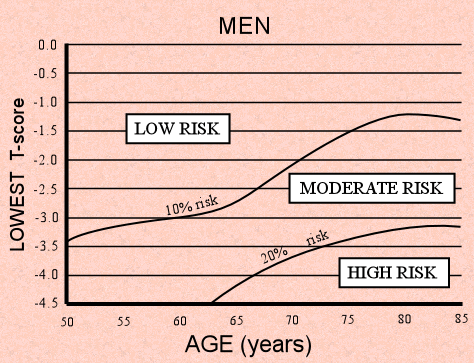Ages greater than 85 are calculated as 85. Why? Because chart ends.
Ages less than 45 are unsuited for calc.
The calculated absolute risk of having a future fragility fracture
during the next 10 years, is based on the bone mineral densitometry BMD values
of T-score and Age. The Calculator is based on the charts shown below, which
come from the references listed.

For men, use the graph below to visually find the level of risk.
(sorry, no auto-calculator for men.)

References
- Siminoski K, Leslie WD, Frame H, et al, Recommendations for bone mineral
density reporting in Canada: a shift to absolute fracture risk assessment.
J Clin Densitom, 2007; 10:120-3
- Siminoski K, Leslie WD, Frame H, et al, Recommendations for bone mineral
density reporting in Canada. Can Assoc Radiol J. 2005; 56:178-88.
- http://www.osteoporosis.ca/local/files/health_professionals/pdfs/CARJ-June05-BMD%20Recomm.pdf
- Kanis JA, Borgstrom F, et al. Assessment of fracture risk. Osteoporos Int 2005 16:581-9.
Disclaimer
This calculator is a tool to be used by qualified professionals
who having training to know when it is appropriate to use it, and when it
is not. Other factors affect risk of fragility fracture, including a history
of prior fractures, metabolic bone- weakening diseases, etc.
If you are wondering, what is a BMD value's T-score, well, then
this calculator isn't for you.
I made this in 2008. Subsequently the FRAX calculator appeared online and has become
the standard used by almost everyone. However, my personal observation of FRAX has noticed some odd
behavior. So keep this calculator in mind if you find FRAX frustrating and mystifying.